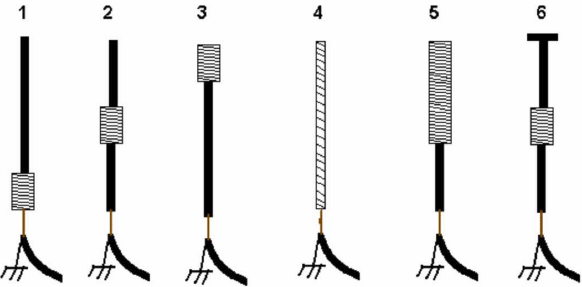|
Doug Flory - WB6BCN Full article: http://download.antennex.com/hws/ws1203/shortant.pdf With a mobile installation and most base locations, the HF seems to pose problems especially using the top band. 160 meters is also known as the top band. It is the only frequency group in the MF band of 300 KHz to 3 MHz that is assigned to region 2 for Amateur Radio usage. It is called the top band because it is on the upper (top) end of the MF band of frequencies. I believe the term may have originated In the 1930s when most Amateur Radio was Top Band; 200 meters and down (1.5 MHz or higher in frequency). One of the biggest problems with a mobile installation for the top band is that the basic 8-foot tall whip only has less than 0.1 ohms radiation resistance. The question is how to raise the radiation resistance to a point where you can get reasonable radiation efficiency. Keep in mind that a 1/4 wave on 1.8 MHz is about 40 meters, or about 130 feet. The most height that you could legally have on a mobile in motion on 160 meters is equal to or less than 1/40th wavelength. The trick is getting the most efficiency with the greatest amount of usable bandwidth at these frequencies. There are many ways to achieve this and most involve some form of inductive or capacitive loading, or both. Unfortunately, the shorter the antenna compared to a 1/4 wave, the less bandwidth it will exhibit. The type of loading used will determine the overall radiation resistance, efficiency, and bandwidth. There are at least six ways to go about loading a short vertical monopole.
(1) Base loading: This type of loading can be either straight series inductance or a transformer arrangement at the feed point or base of the antenna. The inductance requirement is the smallest at this location, but it is not the most efficient. (2) Center loading: This type of loading will require a greater the amount of inductance than the base loading and an increase of coil resistance if the same size material is used. Even though the overall radiation resistance may not be the highest, it is considered to be the best compromise. (3) Top loading: Top loading, if done inductively, requires the greatest amount inductance. On the lower frequency bands, inductive top loading may not be practical. The reason is that the inductance of the coil will be massive and to keep the antenna short will require both larger coil material and coil diameter. (4) Continuous loading: At electrical lengths of 1/8 wave or greater, this is may be the most efficient way to shorten an antenna. It is important to bear in mind that the wire size used, especially at lower frequencies, is very important. (5) 50/50 loading: This is where half the antenna is loading coil and the other half is either straight wire or a mast. In the example shown in the sketch, 50-50 indicates that the load is attached to the mast and the 50+50 has the load attached to the coax. (6) Capacitive top loading combined with center loading is the best way to increase radiation resistance, efficiency and bandwidth. As the antenna approaches 1/4 wave, then just a capacity hat with no other form of loading, is a good solution to increase bandwidth. Top hats will increase the bandwidth, increase the radiation resistance, reduce the required amount of inductance and increase efficiency. A solid disk may the best to use as a top hat, but sometimes not the most practical. Mesh of hardware cloth works well if the size is not too great, or if it is reinforced in some manner. The greater the effective capacitance for a given height, the lower the coil inductance will be for a given antenna height and the greater the bandwidth.
Examples of top hats are a solid disk, a square or rectangular piece of hardware cloth, a piece of hardware cloth cut in the shape of a circle, or for more capacitance, a cone, and a set of spokes. These can be straight out or bent at an angle. There should be a minimum of three spokes. The more you use, within practical limits, the more performance the antenna will exhibit. Top hats can also be added to full sized antennas to increase bandwidth. Keep in mind the antenna length will need to be adjusted to allow for the additional capacitance of the hat. On doublets, it works best if a hat is placed on each end of the antenna. Conclusion There is no single antenna type that is the best performer for all HF bands. For the most part, the center-loaded antenna is the best choice, but the continuously loaded type is the easiest type to construct. The tradeoff with these antennas is that the resistance in the wire can reduce the efficiency. The center-loaded antenna has the best distribution of voltage and current, but can be more difficult to construct. In some, but not all examples used, the center-load is indicated as the most efficient. It is important to keep in mind that the larger the wire diameter, the lower the DC resistance. This factor can determine how well an antenna will perform. The tradeoff here is that larger wires sometimes means extremely large coils.
|

